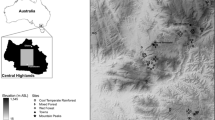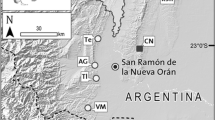Abstract
• Introduction
Various processes contribute to sha** the local assemblage of species in hyperdiverse tropical forest. The relative contribution of environmental factors and dispersal limitation in determining the spatial distribution of saplings at local scale is unclear.
• Methods
We examined two types of environmental factors: (a) soil type reflecting drainage regime and (b) past logging damages reflecting light regime in a neotropical moist forest site. We used a logistic model to predict presence or absence of a given species in a network of elementary small plots.
• Results
The effect of mapped environmental factors and a spatial correlation term were jointly estimated providing a direct measure of the relative role of habitat specialisation and dispersal limitation. At community level, dispersal limitation was the most important determinant of species absence at local scale. The two environmental factors examined played a balanced role. Different species however showed different degrees of dispersal limitation and habitat specialisation. The distribution of a large proportion of species—the majority of the most abundant species—was significantly affected by at least one environmental factor. We provide a ranking of 49 species sensitive to canopy disturbance (from shade specialist to pioneer) and 41 species affected by seasonal flooding (either positively or negatively).
Résumé
Divers processus gouvernent la composition floristique stationnelle en forêt tropicale hyperdiverse. La contribution relative des facteurs environnementaux et de la dispersion limitée n’est pas clairement établie. Nous examinons dans cette étude deux types de contraintes environnementales: le régime de drainage d’une part et l’impact des perturbations d’une exploitation forestière passée d’autre part. Nous utilisons un modèle logistique pour prédire la présence ou l’absence d’une espèce dans un réseau de placettes de 25m2. L’effet de facteurs environnementaux et d’un terme de corrélation spatiale sont estimés conjointement fournissant ainsi pour chaque espèce une estimation du poids relatif de l’affinité avec chacune des caractéristiques environnementales locale et de la limitation de dispersion. A l’échelle de la communauté la limitation de dispersion se révèle être le facteur prépondérant. Les deux variables environnementales semblent jouer un rôle d’importance comparable. Le poids des facteurs varie très nettement entre espèces. La distribution spatiale d’une grande proportion d’espèces —la majorité des espèces les plus abondantes — est sensible à au moins un des deux facteurs environnementaux étudiés. Nous proposons un classement de 49 espèces en termes de sensibilité à l’ouverture de la canopée (depuis les plus sciaphiles jusqu’aux espèces pionnières) et un classement de 41 espèces en termes de sensibilité (attraction ou répulsion) à l’engorgement saisonnier des sols.




Similar content being viewed by others
References
Baraloto C, Morneau F, Bonal D, Blanc L, Ferry B (2007) Seasonal water stress tolerance and habitat associations within four neotropical tree genera. Ecology 88(2):478–489
Barthès B (1991) Influence des caractères pédologiques sur la répartition spatiale de deux espèces du genre Eperua (Caesalpiniaceae) en forêt guyanaise. Revue d'écologie 46(4):303–320
Bell G (2005) The co-distribution of species in relation to the neutral theory of community ecology. Ecology 86:14
Boulet R (1978) Existence de systèmes à forte différentiation latérale en milieu ferralitique guyanais: un nouvel exemple de couverture pédologique en déséquilibre. Sci Sol 2:75–82
Boulet R (1990) Organisation des couvertures pédologiques des bassins versants ECEREX. Hypothèses sur leur dynamique. In: Sarrailh JM (ed) Mise en valeur de l'écosystème forestier guyanais. Opération ECEREX, INRA, CTFT, Paris, Nogent-sur-Marne. pp. 15–45
Condit R, Ashton PS, Baker P, Bunyavejchewin S, Gunatilleke S, Gunatilleke N, Hubbell SP, Foster RB, Itoh A, LaFrankie JV, Lee HS, Losos E, Manokaran N, Sukumar R, Yamakura T (2000) Spatial patterns in the distribution of tropical tree species. Science 288:1414–1418
Dalling JW, Muller-Landau HC, Wright SJ, Hubbell SP (2002) Role of dispersal in the recruitment limitation of neotropical pioneer species. J Ecol 90(4):714–727
de Foresta H, Prévost MF (1986) Végétation pionnière et graines du sol en forêt guyanaise. Biotropica 18(4):279–286
Epron D, Bosc A, Bonal D, Freycon V (2006) Spatial variation of soil respiration across a topographic gradient in a tropical rain forest in French Guiana. J Trop Ecol 22(05):565–574
Flores O (2005) Déterminisme de la régénération chez quinze espèces d'arbres tropicaux en forêt guyanaise: les effets de l'environnement et de la limitation par la dispersion, PhD thesis, Biologie de l'Evolution et Ecologie. Université des Sciences et Techniques, Montpellier, p 166
Gentry AH (1988) Tree species richness of upper Amazonian forests. Proc Natl Acad Sci USA 85(1):156–159
Gourlet-Fleury S, Ferry B, Molino JF, Petronelli P, Schmitt L (eds) (2004) Ecology and Management of a Neotropical Rainforest. Lessons drawn from Paracou, a long-term experimental research site in French Guiana. Elsevier, Paris, pp 3–60
Harms KE, Condit R, Hubbell SP, Foster RB (2001) Habitat associations of trees and shrubs in a 50-ha neotropical forest plot. J Ecol 89(6):947–959
Harrell FE (2001) Regression modeling strategies (with applications to linear models, logistic regression, and survival analysis). Springer, New York, p 568
Hubbell SP, Foster RB (1986) Biology, chance, and the history and structure of tropical rain forest tree communities. In: Diamond J, Case TJ (eds) Community ecology. Harper and Row, New York, pp 314–329
John R, Dalling JW, Harms KE, Yavitt JB, Stallard RF, Mirabello M, Hubbell SP, Valencia R, Navarrete H, Vallejo M, Foster RB (2007) Soil nutrients influence spatial distributions of tropical tree species. Proc Natl Acad Sci USA 104(3):864–869
Keitt TH, Bjornstad ON, Dixon PM, Citron-Pousty S (2002) Accounting for spatial pattern when modeling organism-environment interactions. Ecography 25(5):616–625
Madelaine C, Pélissier R, Vincent G, Molino JF, Sabatier D, Prévost MF, de Namur C (2007) Mortality and recruitment in a lowland tropical rain forest of French Guiana: effects of soil type and species guild. J Trop Ecol 23(03):277–287
Molino JF, Sabatier D (2001) Tree diversity in tropical rain forests: a validation of the intermediate disturbance hypothesis. Science 294(5547):1702–1704
Pélissier R, Dray S, Sabatier D (2002) Within-plot relationships between tree species occurrences and hydrological soil constraints: an example in French Guiana investigated through canonical correlation analysis. Plant Ecol 162(2):143–156
Phillips OL, Vargas PN, Monteagudo AL, Cruz AP, Chuspezans M-E, Washington Galiano S, Yli-Halla M, Rose S (2003) Habitat association among Amazonian Tree Species: a Landscape-Scale Approach. J Ecol 91(5):757–775
Poorter L, Arets EJMM (2003) Light environment and tree strategies in a Bolivian tropical moist forest: an evaluation of the light partitioning hypothesis. Plant Ecol 166(2):295–306
Pulliam HR (2000) On the relationship between niche and distribution. Ecol Lett 3(4):349–361
Sabatier D, Grimaldi M, Prévost M-F, Guillaume J, Gordon M, Dosso M, Curmi P (1997) The influence of soil cover organization on the floristic and structural heterogeneity of a Guianan rain forest. Plant Ecol 131:81–108
Sollins P (1998) Factors influencing species composition in tropical lowland rain forest: does soil matter? Ecology 79:23–30
ter Steege H, Sabatier D, Castellanos H, Andel T v, Duivenvoorden JF, Oliveira AAd, Ek RC, Lilwah R, Maas PJM, Mori SA (2000) An analysis of the floristic composition and diversity of Amazonian forests including those of the Guiana shield. J Trop Ecol 16:801–828
Traissac S (2003) Dynamique spatiale de Vouacapoua americana (Aublet), arbre de forêt tropicale humide à répartition agrégée. Ph.D. thesis, Laboratoire de Biométrie et de Biologie Evolutive UMR 5558, Université Claude Bernard Lyon I, Lyon. p 230
Valencia R, Balslev H, Miño G Paz y (1994) High tree alpha-diversity in Amazonian Ecuador. Biodivers Conserv 3(1):21–29
Vincent G, Weissenbacher E, Sabatier D, Blanc L, Proisy C, Couteron P (2010) Détection des variations de structure de peuplements en forêt dense tropicale humide par Lidar aéroporté (Small foot-print airborn LiDAR proves highly sensitive to changes in structure of moist tropical forest). Revue Française de Photogrammétrie et Télédectection 191:42–51
Webb CO, Peart DR (2000) Habitat associations of trees and seedlings in a Bornean rain forest. J Ecol 88(3):464–478
Wright SJ, Muller-Landau HC, Condit R, Hubbell SP (2003) Gap-dependent recruitment, realized vital rates and size distributions of tropical trees. Ecology 84(12):3174–3185
Acknowledgements
The authors thank François Munoz for comments on an earlier draft and Vivien Rossi for helpful discussions on statistical issues. Many thanks to Lilian Blanc for making available sapling inventory data (dataset 2) and the canopy disturbance map of the CIRAD Paracou experimental site. This study benefited from partial funding by the European Regional Development Fund (convention n° 2828).
Author information
Authors and Affiliations
Corresponding author
Additional information
Handling Editor: Erwin Dreyer
Rights and permissions
About this article
Cite this article
Vincent, G., Molino, JF., Marescot, L. et al. The relative importance of dispersal limitation and habitat preference in sha** spatial distribution of saplings in a tropical moist forest: a case study along a combination of hydromorphic and canopy disturbance gradients. Annals of Forest Science 68, 357–370 (2011). https://doi.org/10.1007/s13595-011-0024-z
Received:
Accepted:
Published:
Issue Date:
DOI: https://doi.org/10.1007/s13595-011-0024-z




